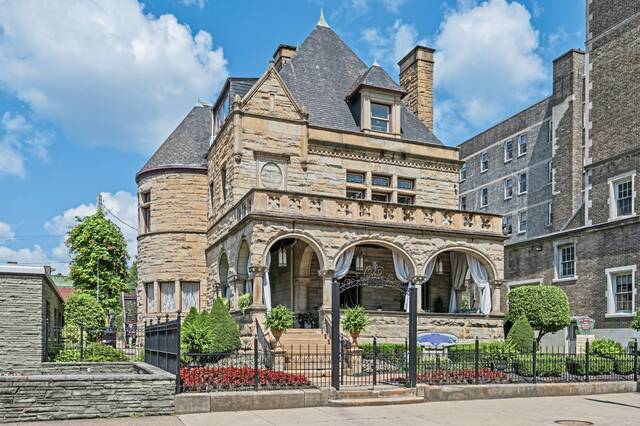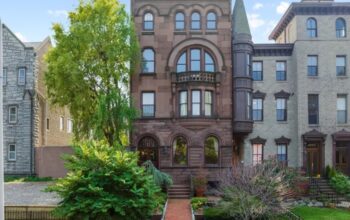The historic 1888 Boggs Mansion on the North Side is on the market for $2.5 million. It’s made of stone and has its original slate roof. It’s 9,000 square feet with eight guest rooms and nine bathrooms, a third floor ballroom, a European fireplace made of blood marble — a sturdy substance normally used to build royal tombs — finely crafted American chestnut woodwork and a dramatic spiral staircase.
If that weren’t enough, rumor has it there’s a hidden painting underneath the painted over beams in the ceiling, a secret basement and a ghost that witnesses claim to have seen gliding up the stairs.
It’s the Boggs Mansion and it can be yours for $2.5 million .
“It’s like ‘Gone with the Wind’ inside,” said Jeff Stasko, 65, who owns the house with his husband Karl Kargle, 75. “It’s got a grand staircase, beautiful marble fireplaces. It’s just a grand house, beautiful inside. It has nice, big spacious rooms. It’s right across (West North Avenue) from (West) Park and Lake Elizabeth with a skyline view of the City of Pittsburgh.” A European fireplace made of blood marble inside the Boggs Mansion on the North Side. It was owned by one of the wealthiest families in the City of Pittsburgh, headed by Russell H. Boggs, who made his fortune owning the Boggs and Buhl department store on the North Side with his business partner Henry Buhl. Boggs had the house built in 1888 and curious employees would come by to check out the place for themselves.
“It’s a miniature ‘Downton Abbey’ in Pittsburgh,” Stasko said.
Built by H.H. Richardson, who designed the Allegheny County Courthouse, it became a party place for Pittsburgh’s elite, including Andrew Carnegie and Henry Frick.
“When you came to this home, you were dressed to the T — top coats and top hats and women in their finest gowns and jewelry,” Stasko said.
Realtor/advisor Jason Carr of Compass Real Estate said that when it comes to this property, there’s a lot to be impressed by.
“I’m fascinated with the imprint that the Boggs mansion has left on the old Allegheny City corridor. Vibrant tales of dinner parties and affluent Pittsburgh aristocrats and debutants, bloodstone marble reserved for royalty, rare American chestnut paneling — there’s just so much to marvel at,” Carr said.
For all of its history, the house eventually fell into disrepair. Boggs died in 1922 from injuries suffered playing polo and the place eventually deteriorated badly. It likely would have been demolished had it not been for Stasko and Kargle, both retired teachers who committed themselves to the monumental task of restoring the Boggs mansion.
“We wanted to bring it back to the way it was when the Boggs owned the home,” Stasko said.
“It was a lot of work,” Stasko said, adding that they put $1.5 million into the restoration.





